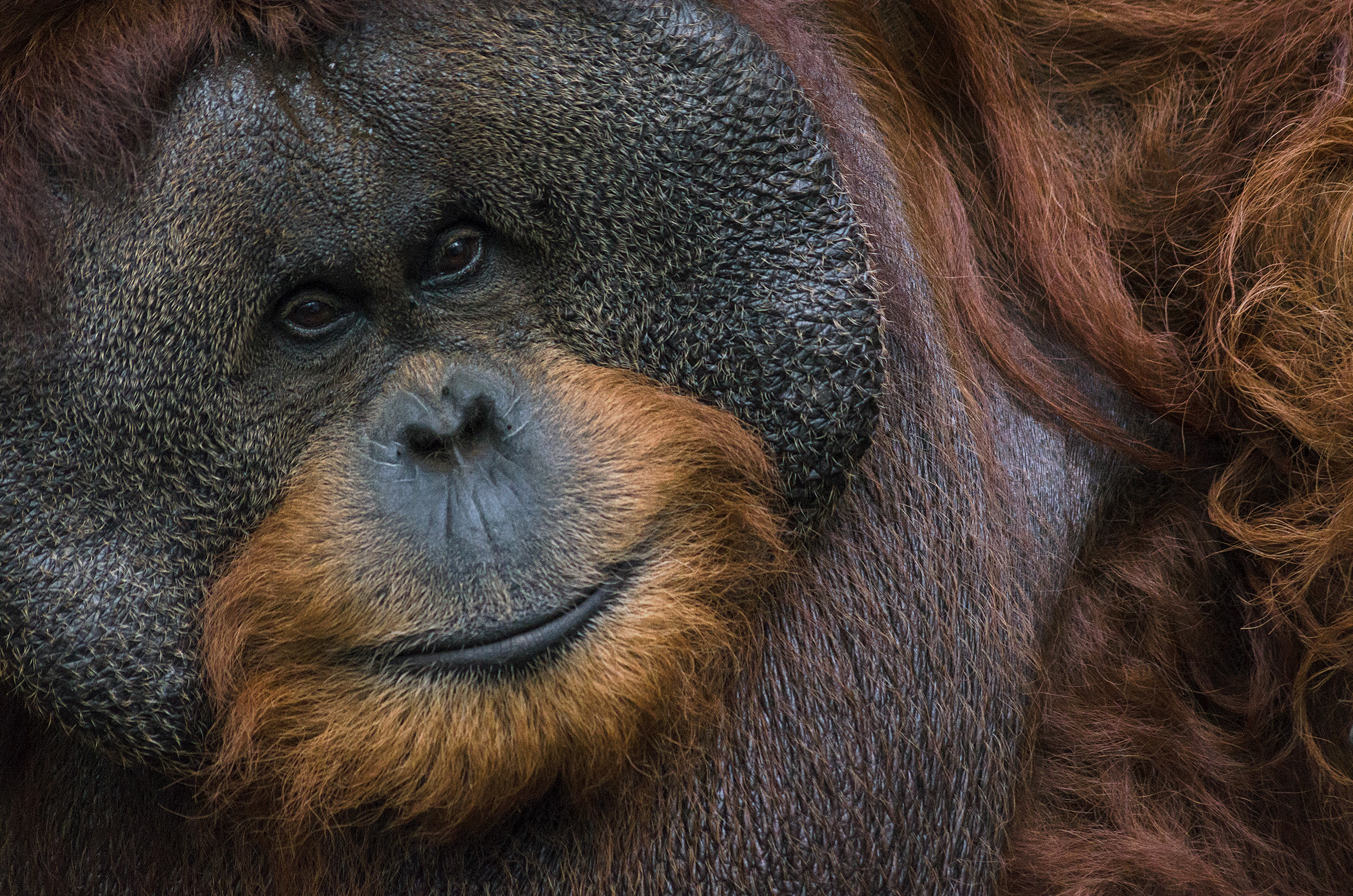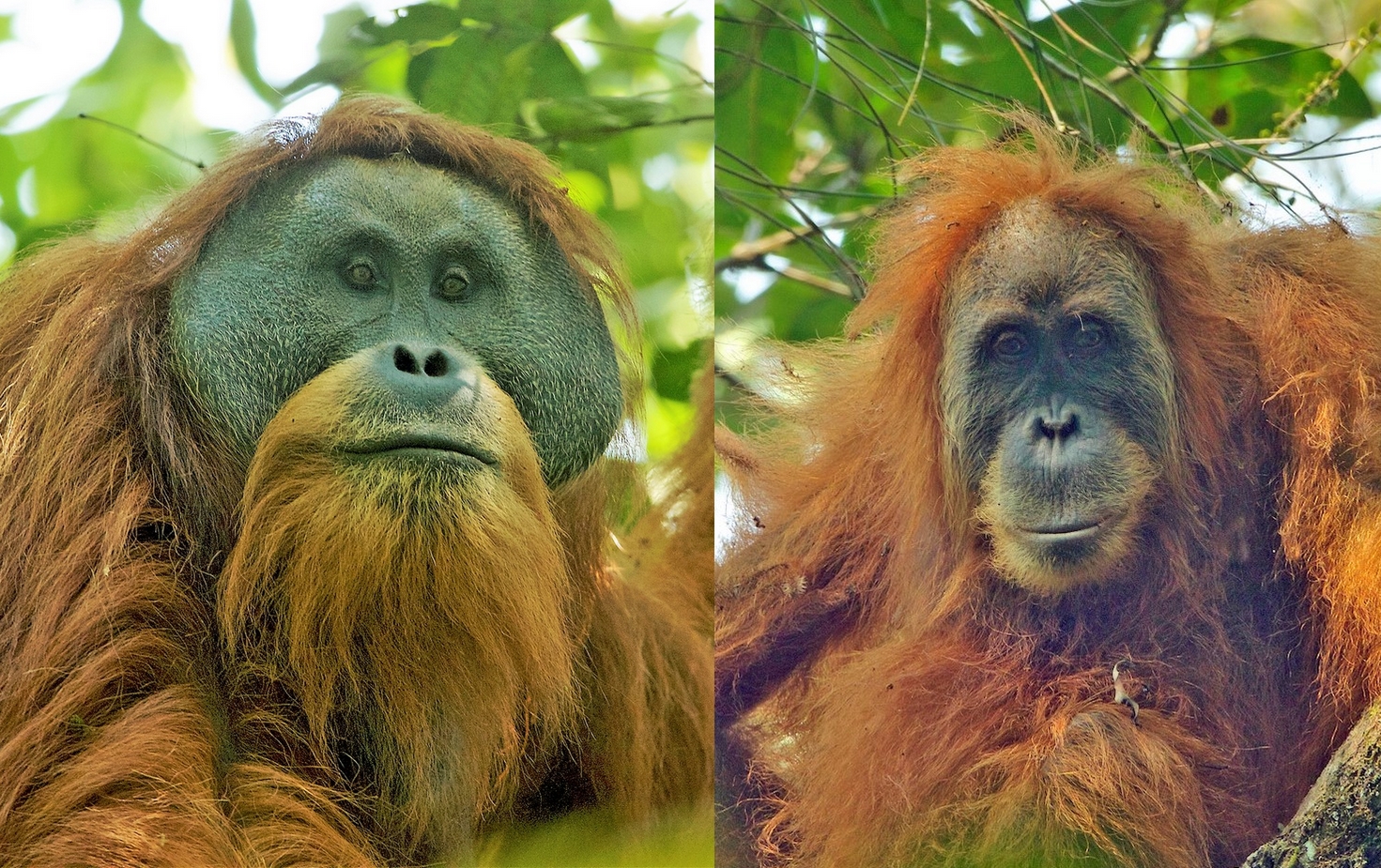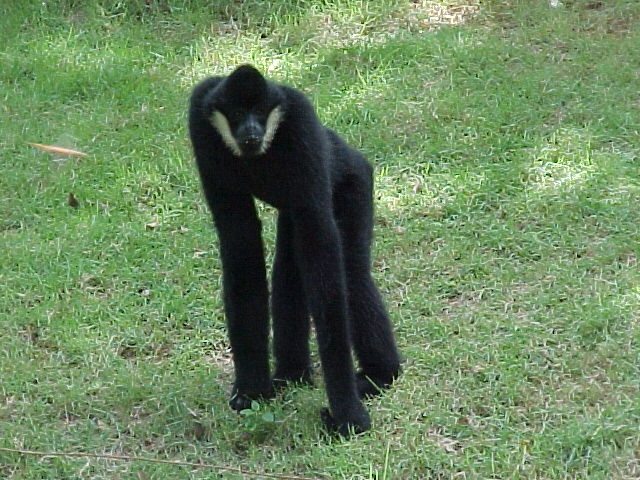|
Hominid
The Hominidae (), whose members are known as the great apes or hominids (), are a taxonomic family of primates that includes eight extant species in four genera: '' Pongo'' (the Bornean, Sumatran and Tapanuli orangutan); '' Gorilla'' (the eastern and western gorilla); '' Pan'' (the chimpanzee and the bonobo); and ''Homo'', of which only modern humans (''Homo sapiens'') remain. Numerous revisions in classifying the great apes have caused the use of the term ''hominid'' to change over time. The original meaning of "hominid" referred only to humans (''Homo'') and their closest extinct relatives. However, by the 1990s humans and other apes were considered to be "hominids". The earlier restrictive meaning has now been largely assumed by the term ''hominin'', which comprises all members of the human clade after the split from the chimpanzees (''Pan''). The current meaning of "hominid" includes all the great apes including humans. Usage still varies, however, and some scientis ... [...More Info...] [...Related Items...] OR: [Wikipedia] [Google] [Baidu] |
Homo
''Homo'' () is a genus of great ape (family Hominidae) that emerged from the genus ''Australopithecus'' and encompasses only a single extant species, ''Homo sapiens'' (modern humans), along with a number of extinct species (collectively called archaic humans) classified as either ancestral or closely related to modern humans; these include ''Homo erectus'' and ''Homo neanderthalensis''. The oldest member of the genus is ''Homo habilis'', with records of just over 2 million years ago. ''Homo'', together with the genus ''Paranthropus'', is probably most closely related to the species ''Australopithecus africanus'' within ''Australopithecus''.'''' The closest living relatives of ''Homo'' are of the genus ''Pan (genus), Pan'' (chimpanzees and bonobos), with the ancestors of ''Pan'' and ''Homo'' estimated to have diverged around 5.7–11 million years ago during the Late Miocene. ''H. erectus'' appeared about 2 million years ago and spread throughout Africa (deba ... [...More Info...] [...Related Items...] OR: [Wikipedia] [Google] [Baidu] |
Homininae
Homininae (the hominines) is a subfamily of the family Hominidae (hominids). (The Homininae——encompass humans, and are also called "African hominids" or "African apes".) This subfamily includes two tribes, Hominini and Gorillini, both having extant (or living) species as well as extinct species. Tribe Hominini includes: the extant genus ''Homo'', which comprises only one extant species—the modern humans (''Homo'' sapiens), and numerous extinct human species; and the extant genus '' Pan'', which includes two extant species, chimpanzees and bonobos. Tribe Gorillini (gorillas) contains one extant genus, Gorilla, with two extant species, with variants, and one known extinct genus. Alternatively, the genus ''Pan'' is considered by some to belong, instead of to a subtribe Panina, to its own separate tribe, (''so-called'') "Panini"—which would be a third tribe for Homininae. Some classification schemes provide a more comprehensive account of extinct groups—(see section "Taxo ... [...More Info...] [...Related Items...] OR: [Wikipedia] [Google] [Baidu] |
Hominini
The Hominini (hominins) form a Tribe (biology), taxonomic tribe of the subfamily Homininae (hominines). They comprise two extant genera: ''Homo'' (humans) and ''Pan (genus), Pan'' (chimpanzees and bonobos), and in standard usage exclude the genus ''Gorilla (genus), Gorilla'' (gorillas), which is grouped separately within the subfamily Homininae. The term Hominini was originally introduced by Camille Arambourg (1948), who combined the categories of ''Hominina'' and ''Simiina'' pursuant to John Edward Gray, Gray's classifications (1825). Traditionally, chimpanzees, gorillas and orangutans were grouped together, excluding humans, as pongidae, pongids. Since Gray's classifications, evidence accumulating from genetic phylogeny confirmed that humans, chimpanzees, and gorillas are more closely related to each other than to the orangutan. The orangutans were reassigned to the family Hominidae (great apes), which already included humans; and the gorillas were grouped as a separate tr ... [...More Info...] [...Related Items...] OR: [Wikipedia] [Google] [Baidu] |
Human
Humans (''Homo sapiens'') or modern humans are the most common and widespread species of primate, and the last surviving species of the genus ''Homo''. They are Hominidae, great apes characterized by their Prehistory of nakedness and clothing#Evolution of hairlessness, hairlessness, bipedality, bipedalism, and high Human intelligence, intelligence. Humans have large Human brain, brains, enabling more advanced cognitive skills that facilitate successful adaptation to varied environments, development of sophisticated tools, and formation of complex social structures and civilizations. Humans are Sociality, highly social, with individual humans tending to belong to a Level of analysis, multi-layered network of distinct social groups — from families and peer groups to corporations and State (polity), political states. As such, social interactions between humans have established a wide variety of Value theory, values, norm (sociology), social norms, languages, and traditions (co ... [...More Info...] [...Related Items...] OR: [Wikipedia] [Google] [Baidu] |
Orangutan
Orangutans are great apes native to the rainforests of Indonesia and Malaysia. They are now found only in parts of Borneo and Sumatra, but during the Pleistocene they ranged throughout Southeast Asia and South China. Classified in the genus ''Pongo'', orangutans were originally considered to be one species. In 1996, they were divided into two species: the Bornean orangutan (''P. pygmaeus'', with three subspecies) and the Sumatran orangutan (''P. abelii''); a third species, the Tapanuli orangutan (''P. tapanuliensis''), was identified definitively in 2017. The orangutans are the only surviving members of the subfamily Ponginae, which diverged genetically from the other hominids (gorillas, chimpanzees, and humans) between 19.3 and 15.7 million years ago. The most arboreal of the great apes, orangutans spend most of their time in trees. They have proportionally long arms and short legs, and have reddish-brown hair covering their bodies. Adult males weigh about , while female ... [...More Info...] [...Related Items...] OR: [Wikipedia] [Google] [Baidu] |
Ponginae
Ponginae , also known as the Asian hominids, is a subfamily in the family (biology), family Hominidae. Once a diverse lineage of Eurasian apes, the subfamily has only one Neontology, extant genus, ''Pongo (genus), Pongo'' (orangutans), which contains three extant species; the Sumatran orangutan (''Pongo abelii''), the Tapanuli orangutan (''Pongo tapanuliensis'') and the Bornean orangutan (''Pongo pygmaeus''). All three species are listed as critically endangered by the International Union for Conservation of Nature (IUCN). Evolutionary history The first pongine genera appear in the Miocene, ''Sivapithecus'' and ''Khoratpithecus'', six or seven million years before evidence of orangutans was found from Pleistocene southeast Asia and southern China. Ponginae may also include the genera ''Lufengpithecus'', ''Ankarapithecus'', and ''Gigantopithecus''. However, phylogenetic analysis in 2004, which originally found ''Lufengpithecus'' and ''Ankarapithecus'' to be most closely related to ... [...More Info...] [...Related Items...] OR: [Wikipedia] [Google] [Baidu] |
Bornean Orangutan
The Bornean orangutan (''Pongo pygmaeus'') is an orangutan species endemic to the island of Borneo. It belongs to the only genus of great apes native to Asia and is the largest of the three ''Pongo'' species. It has a coarse, reddish coat and up to long arms. It is sexually dimorphic — males are larger than females and develop large cheek pads (flanges), for example. The Bornean orangutan inhabits Borneo lowland rain forests and Borneo montane rain forests up to an elevation of . Its diet includes fruits, seeds, flowers, bird eggs, sap and vines. It is highly intelligent, displaying tool use and distinct cultural patterns. It is critically endangered, with deforestation, palm oil plantations, and hunting posing a serious threat to its survival. Taxonomy The Bornean orangutan and the Sumatran orangutan diverged about 400,000 years ago, with a continued low level of gene flow between them since then. The two orangutan species were considered merely subspecies until 1996; they ... [...More Info...] [...Related Items...] OR: [Wikipedia] [Google] [Baidu] |
Orangutan
Orangutans are great apes native to the rainforests of Indonesia and Malaysia. They are now found only in parts of Borneo and Sumatra, but during the Pleistocene they ranged throughout Southeast Asia and South China. Classified in the genus ''Pongo'', orangutans were originally considered to be one species. In 1996, they were divided into two species: the Bornean orangutan (''P. pygmaeus'', with three subspecies) and the Sumatran orangutan (''P. abelii''); a third species, the Tapanuli orangutan (''P. tapanuliensis''), was identified definitively in 2017. The orangutans are the only surviving members of the subfamily Ponginae, which diverged genetically from the other hominids (gorillas, chimpanzees, and humans) between 19.3 and 15.7 million years ago. The most arboreal of the great apes, orangutans spend most of their time in trees. They have proportionally long arms and short legs, and have reddish-brown hair covering their bodies. Adult males weigh about , while female ... [...More Info...] [...Related Items...] OR: [Wikipedia] [Google] [Baidu] |
Pan (genus)
The genus ''Pan'' consists of two extant species: the chimpanzee and the bonobo. Taxonomically, these two ape species are collectively termed panins; however, both species are more commonly referred to collectively using the generalized term chimpanzees, or chimps. Together with humans, gorillas, and orangutans, they are part of the family Hominidae (the great apes, or ''hominids''). Native to sub-Saharan Africa, chimpanzees and bonobos are currently both found in the Congo jungle, while only the chimpanzee is also found further north in West Africa. Both species are listed as endangered species, endangered on the IUCN Red List of Threatened Species, and in 2017 the Convention on Migratory Species selected the chimpanzee for special protection. Chimpanzee and bonobo: comparison The chimpanzee (''P. troglodytes''), which lives north of the Congo River, and the bonobo (''P. paniscus''), which lives south of it, were once considered to be the same species, but since 1928 they h ... [...More Info...] [...Related Items...] OR: [Wikipedia] [Google] [Baidu] |
Gibbon
Gibbons () are apes in the family Hylobatidae (). The family historically contained one genus, but now is split into four extant genera and 20 species. Gibbons live in subtropical and tropical forests from eastern Bangladesh and Northeast India to Southeast Asia and Indonesia (including the islands of Sumatra, Borneo and Java). Also called the lesser apes, gibbons differ from the great apes ( chimpanzees, gorillas, orangutans and humans) in being smaller, exhibiting low sexual dimorphism, and not making nests. Like all of the apes, gibbons are tailless. Unlike most of the great apes, gibbons frequently form long-term pair bonds. Their primary mode of locomotion, brachiation, involves swinging from branch to branch for distances up to , at speeds as fast as . They can also make leaps up to , and walk bipedally with their arms raised for balance. They are the fastest of all tree-dwelling, nonflying mammals. Depending on the species and sex, gibbons' fur coloration varies from ... [...More Info...] [...Related Items...] OR: [Wikipedia] [Google] [Baidu] |




